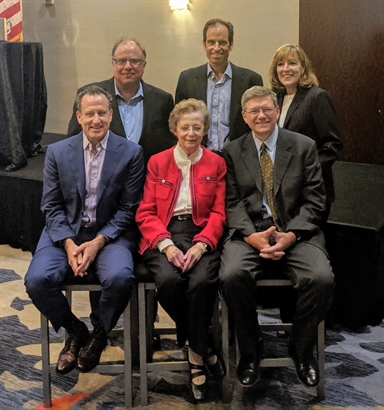Frank Sander and the Multidoor Courthouse
September 11, 2019 by Colin Rule

Back: Daniel Rodriguez (Dean of Northwestern University Pritzker School of Law, Chair of ABA Innovations Committee); Tom Sander (Frank’s Son); Harrie Samaras (Chair of the ABA Dispute Resolution Section); Front: Ernest Sander (Frank’s other son); Edith Primm (Executive Director, Justice Center of Atlanta); Colin Rule.
On Aug. 9, I was honored (along with the legendary Edith Primm of the Justice Center of Atlanta) to be the first recipient of the American Bar Association’s Frank Sander Award for innovation in alternative dispute resolution (ADR).
Frank Sander has been a hero of mine since I started in the field almost 30 years ago. It’s undeniably true that each of us stands on the shoulders of the giants who came before us. No one in the ADR field has broader shoulders than Frank. His 1976 speech at the Pound Conference is the “big bang” moment in the history of ADR; many see it as the birth of the field, which makes Frank the father of ADR.
A Vision of Justice
Frank’s 1976 speech, “Varieties of Dispute Processing,” envisioned a future justice system that could direct parties into appropriate pathways customized to the particulars of their dispute. Though he didn’t title this concept the “multidoor courthouse” in his speech, the name (coined by a journalist) eventually stuck, and it has become a central concept in the dispute resolution field. Frank wondered aloud in his speech whether the “courts of the future” — in particular, “courts around the year 2000” — might help to screen incoming complaints, sorting them according to criteria aimed at matching the case with the most appropriate form of resolution. In 1994, he wrote an article describing this process as “fitting the forum to the fuss,” oft quoted in dispute systems design classes to this very day.
I have many heroes in ADR who inspire my work every day, and I’ve come to realize that most of them feel about Frank the way I feel about them. Many of them trace their life’s work in ADR directly back to Frank’s vision and mentoring. And that’s easy to understand.
It is difficult to overstate Frank’s foundational role in establishing the field of ADR. Along with Roger Fisher, Frank is the reason why we have mediation and negotiation in course offerings at virtually every law school across the country. As the special issue of Dispute Resolution Magazine noted, he “shepherded an ad hoc Committee on the Resolution of Minor Disputes into a Standing Committee on Dispute Resolution, and then, ultimately, the Section of Dispute Resolution. He also came to mentor not only the field’s first-generation academics but its first-generation practitioners, court administrators, and even judges. But he also subtly mentored the maturation of the field in meaningful ways, by providing the intellectual backbone of such institutional landmarks of the field as the National Standards for Court Connected Mediation and, later, the Uniform Mediation Act.” He also edited the ABA’s Dispute Resolution Magazine for more than 18 years, always striving to find new voices who could speak to new directions in ADR practice.
Thousands of Virtual Doors
Frank was not only a thought leader and scholar, he embodied the very personality of the ADR field: optimistic, open-minded, curious, collaborative, and empathetic. Two colleagues and friends, David Hoffman and Michael Moffitt, who worked closely with Frank, have written of Frank’s curiosity, candor, and compassion as shaping the evolution of the field. Those personal characteristics became central to the field itself.
I see Modria’s work in expanding access to justice through ODR in exactly these terms. When Frank spoke about “courts of the future” in the “year 2000,” I think he was envisioning something along the lines of the work we’re doing in ODR. Instead of a clerk at a desk routing disputants to one of a dozen doors inside a physical building, we want to make every mobile phone a point of access to justice, with hundreds or thousands of virtual doors available to “fit each fuss” to a specifically-crafted, appropriate forum for resolution. As the adoption of ODR by courts continues to accelerate, growing from dozens to hundreds to thousands, I draw a direct line back to Frank’s prophetic vision in his 1976 speech. I feel like I am an inheritor of Frank’s innovation, handed the torch from my mentors, to continue the work beyond the scope of any of our lives. Soon, I’ll be handing it off to the next generation.
Ongoing Spirit of Innovation
Richard and Margaret put it eloquently in the special edition: “It is a rare person who through his own thoughts and efforts can truly be said to have changed this country, and the world, for the better. Fewer still do it with humility and grace. Frank E. A. Sander is one such transformative figure, a man who for nearly 40 years has nurtured the field of dispute resolution that today is credited as being one of the most significant shifts in American law. Inspired by his ideas and efforts, the resolution of legal problems is faster, more humane, more effective, and less costly for those in the United States and across the globe.” In this, I see Frank’s vision and my work with Tyler Technologies as one and the same. My goal is to keep the spirit of Frank’s innovation alive and well, and to bring it into the new era.

Colin Rule was recently awarded the Frank Sanders Award by the American Bar Association. This is the fourth post in a series on ODR by Rule, vice president, Online Dispute Resolution and co-founder of Modria. Check this space on the second Wednesday of each month for more.
Read his earlier articles here:
How ODR Can Benefit Three Criminal Case Types
The Intriguing Evolution of ODR
ODR Around the World